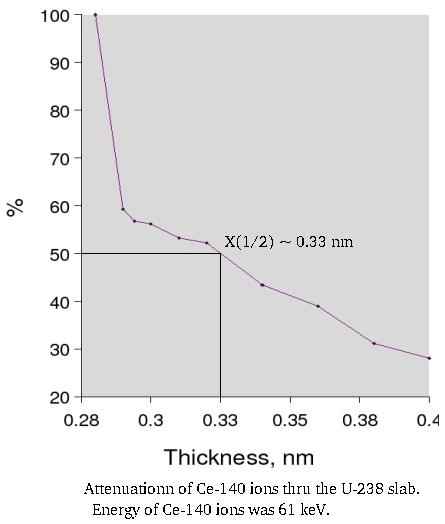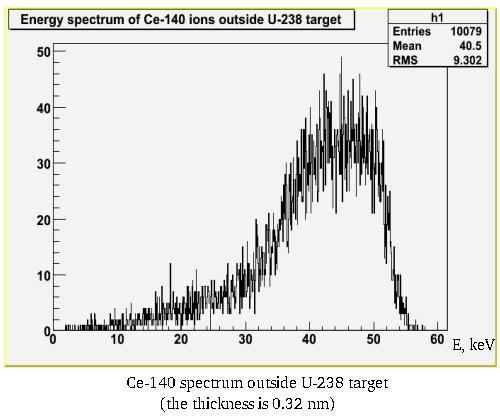Difference between revisions of "July, 6, 2007 Investigations of Geometry Influence on the Fission Fragments Behaviour"
| (45 intermediate revisions by the same user not shown) | |||
| Line 1: | Line 1: | ||
== 1. Theoretical Calculations == | == 1. Theoretical Calculations == | ||
| − | Relativistic charged | + | Relativistic charged particles lose energy in matter primarily by ionization. The mean rate of energy loss is given by the Bethe_Bloch equation,<br> |
| − | -<math>\frac{dE}{dx}</math>=K<math>z^2\frac{Z}{A}</math><math>\frac{1}{\beta^2}</math>[<math>\frac{1}{2}\ln\frac{2m_ec^2\beta^2\gamma^ | + | - <math>\frac{dE}{dx}</math>=K<math>z^2\frac{Z}{A}</math><math>\frac{1}{\beta^2}</math>[<math>\frac{1}{2}\ln\frac{2m_ec^2\beta^2\gamma^2T_{max}}{I^2}</math> - <math>\beta^2</math> - <math>\frac{\delta}{2}</math>]<br> |
| + | <math>\frac{K}{A}</math> = 0.307075 MeV <math>g^{-1} cm^2</math><br> | ||
| + | <math>T_{max}</math>=61 keV<br> | ||
| + | <math>\beta</math>=0.033<br> | ||
| + | For example, for incident particle Ce-140 and target U-238, we have following results for energy loss<br> | ||
| + | Density of Uranium is 19.1 <math>\frac{g}{cm^3}</math> [http://hypertextbook.com/facts/2006/MichaelMirochnik.shtml]<br> | ||
| + | |||
| + | - <math>\frac{dE}{dx}</math>=<math>0.3071*58^2*19.1</math> <math>{\frac{92}{140}} {\frac{1}{0.033^2}} \frac{1}{2}\ln[\frac{2*0.51*0.033^2*0.061}{883.2^2*10^{-12}}]</math> = 2.66 <math>\frac{MeV}{nm}</math><br> | ||
| + | The half length <math>X_{\frac{1}{2}}</math> is the distance needed to reduce the intensity in half <br> | ||
| + | |||
| + | <math>X_{\frac{1}{2}}</math> = <math>\frac{61}{2*2.66*10^3}</math> nm = 0.0115 nm<br> | ||
| + | |||
| + | Time t=<math>\frac{0.0115*10^{-9}}{0.033*3*10^8}</math> = <math>1.16*10^{-9}</math> nsec | ||
| + | |||
| + | == 2. Simulation == | ||
| + | |||
| + | (i) Simulated half-length for totally ionized unexited Ce-140 (A=140, Z=58, Q=58, E'=0) having energy 61 keV propagated thru the U-238 target: | ||
| + | |||
| + | [[Image:Ce_attenuation_U_2.jpg]] | ||
| + | |||
| + | Half-length: | ||
| + | |||
| + | <math>X_{\frac{1}{2}} = 0.33 nm = 3.3 A </math> | ||
| + | |||
| + | Time needed to the Ce-140 ion to pass half-length: | ||
| + | |||
| + | Time = <math>3.3*10^{-17} s</math> | ||
| + | |||
| + | (ii) Energy spectrum of Ce-140 ions (E = 61 keV). Number of incident ions was 20,000: | ||
| + | |||
| + | [[Image:Energy_sp_Ce.jpg]] | ||
Latest revision as of 00:13, 9 July 2007
1. Theoretical Calculations
Relativistic charged particles lose energy in matter primarily by ionization. The mean rate of energy loss is given by the Bethe_Bloch equation,
- =K[ - - ]
= 0.307075 MeV
=61 keV
=0.033
For example, for incident particle Ce-140 and target U-238, we have following results for energy loss
Density of Uranium is 19.1 [1]
- = = 2.66
The half length is the distance needed to reduce the intensity in half
= nm = 0.0115 nm
Time t= = nsec
2. Simulation
(i) Simulated half-length for totally ionized unexited Ce-140 (A=140, Z=58, Q=58, E'=0) having energy 61 keV propagated thru the U-238 target:
Half-length:
Time needed to the Ce-140 ion to pass half-length:
Time =
(ii) Energy spectrum of Ce-140 ions (E = 61 keV). Number of incident ions was 20,000:

